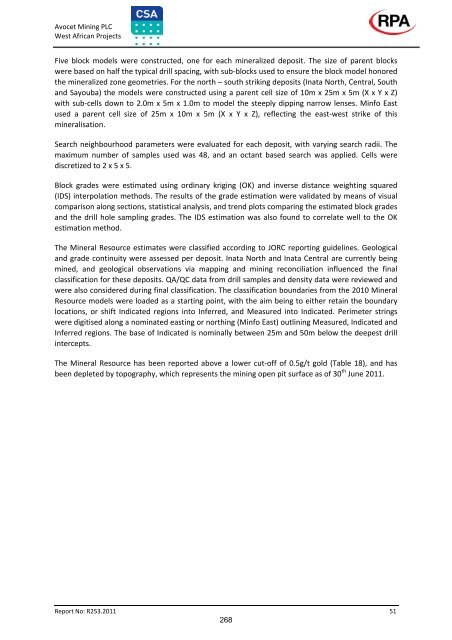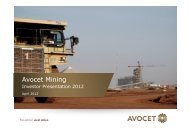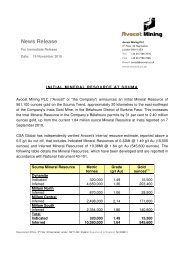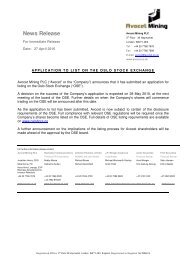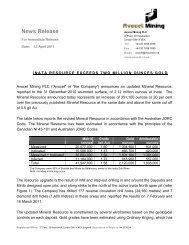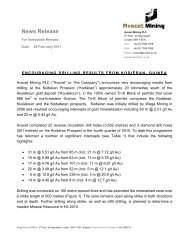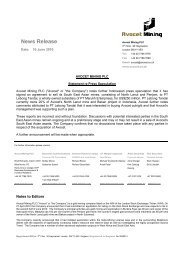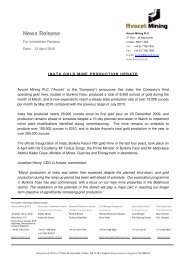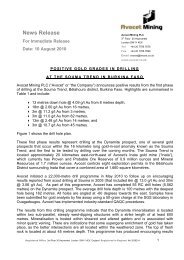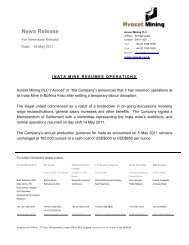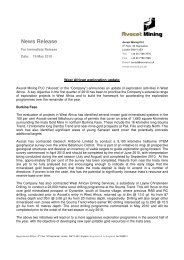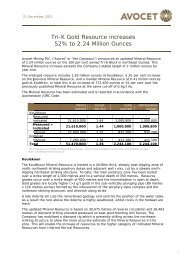<strong>Avocet</strong> <strong>Mining</strong> <strong>PLC</strong> West African Projects Five block models were constructed, one for each mineralized deposit. The size of parent blocks were based on half the typical drill spacing, with sub‐blocks used to ensure the block model honored the mineralized zone geometries. For the north – south striking deposits (Inata North, Central, South and Sayouba) the models were constructed using a parent cell size of 10m x 25m x 5m (X x Y x Z) with sub‐cells down to 2.0m x 5m x 1.0m to model the steeply dipping narrow lenses. Minfo East used a parent cell size of 25m x 10m x 5m (X x Y x Z), reflecting the east‐west strike of this mineralisation. Search neighbourhood parameters were evaluated for each deposit, with varying search radii. The maximum number of samples used was 48, and an octant based search was applied. Cells were discretized to 2 x 5 x 5. Block grades were estimated using ordinary kriging (OK) and inverse distance weighting squared (IDS) interpolation methods. The results of the grade estimation were validated by means of visual comparison along sections, statistical analysis, and trend plots comparing the estimated block grades and the drill hole sampling grades. The IDS estimation was also found to correlate well to the OK estimation method. The Mineral Resource estimates were classified according to JORC reporting guidelines. Geological and grade continuity were assessed per deposit. Inata North and Inata Central are currently being mined, and geological observations via mapping and mining reconciliation influenced the final classification for these deposits. QA/QC data from drill samples and density data were reviewed and were also considered during final classification. The classification boundaries from the 2010 Mineral Resource models were loaded as a starting point, with the aim being to either retain the boundary locations, or shift Indicated regions into Inferred, and Measured into Indicated. Perimeter strings were digitised along a nominated easting or northing (Minfo East) outlining Measured, Indicated and Inferred regions. The base of Indicated is nominally between 25m and 50m below the deepest drill intercepts. The Mineral Resource has been reported above a lower cut‐off of 0.5g/t gold (Table 18), and has been depleted by topography, which represents the mining open pit surface as of 30 th June <strong>2011</strong>. Report No: R253.<strong>2011</strong> 51 268
<strong>Avocet</strong> <strong>Mining</strong> <strong>PLC</strong> West African Projects Table 18 Mineral Resource Report, AU (OK) >0.5g/t as at 30 th June <strong>2011</strong> Deposit Inata North Inata Central Inata South Sayouba Minfo East Total Gross Net attributable to <strong>Avocet</strong> <strong>Mining</strong> Classification Au Au Tonnes Ounces Tonnes g/t g/t Ounces Measured 10,070,000 1.77 573,400 9,063,000 1.77 516,100 Indicated 20,400,000 1.30 852,100 18,360,000 1.30 766,900 Meas + Ind 30,470,000 1.45 1,425,400 27,423,000 1.45 1,282,900 Inferred 7,300,000 1.40 327,300 6,570,000 1.40 294,600 Total 37,770,000 1.44 1,752,800 33,993,000 1.44 1,577,500 Measured 5,740,000 1.79 330,100 5,166,000 1.79 297,100 Indicated 5,490,000 1.48 261,200 4,941,000 1.48 235,100 Meas + Ind 11,240,000 1.64 591,400 10,116,000 1.64 532,300 Inferred 4,280,000 1.41 194,300 3,852,000 1.41 174,900 Total 15,520,000 1.57 785,700 13,968,000 1.57 707,100 Measured 1,420,000 1.23 56,100 1,278,000 1.23 50,500 Indicated 4,110,000 1.44 190,100 3,699,000 1.44 171,100 Meas + Ind 5,530,000 1.38 246,200 4,977,000 1.38 221,600 Inferred 130,000 1.02 4,200 117,000 1.02 3,800 Total 5,660,000 1.38 250,400 5,094,000 1.38 225,400 Measured 440,000 1.42 20,000 396,000 1.42 18,000 Indicated 2,260,000 1.12 81,200 2,034,000 1.12 73,100 Meas + Ind 2,700,000 1.17 101,200 2,430,000 1.17 91,100 Inferred 780,000 1.10 27,600 702,000 1.10 24,800 Total 3,480,000 1.15 128,900 3,132,000 1.15 116,000 Measured ‐ ‐ ‐ ‐ ‐ ‐ Indicated 3,830,000 1.44 177,200 3,447,000 1.44 159,500 Meas + Ind 3,830,000 1.44 177,200 3,447,000 1.44 159,500 Inferred 5,170,000 1.62 269,400 4,653,000 1.62 242,500 Total 9,000,000 1.54 446,500 8,100,000 1.54 401,900 Measured 17,672,000 1.72 979,600 15,903,000 1.72 881,600 Indicated 36,101,000 1.35 1,561,800 32,490,000 1.35 1,405,600 Meas + Ind 53,772,000 1.47 2,541,400 48,393,000 1.47 2,287,300 Inferred 17,663,000 1.45 822,900 15,894,000 1.45 740,600 Total 71,435,000 1.46 3,364,300 64,296,000 1.46 3,027,900 Note: Differences may occur due to rounding. The Mineral Resource was estimated by Mr David Williams (MAusIMM) of CSA. Mr Williams is a Competent Person as defined by the Australasian Code for the reporting of Exploration Results, Mineral Resources and Ore Reserves (the JORC Code 2004 Edition) and consents to the inclusion in this report on the matters based on his information in the form and context in which it appears. The above figures have been depleted for mining operations as of 30 June <strong>2011</strong>. The resource was estimated within constraining wireframe solids based on a nominal lower cut‐off grade of 0.3 g/t Au. The resource is quoted from blocks above 0.5 g/t Au. Differences may occur due to rounding. The net attributable to <strong>Avocet</strong> <strong>Mining</strong> amounts to 90% of the gross Mineral Resource. Report No: R253.<strong>2011</strong> 52 269
- Page 1 and 2:
AVOCET MINING PLC * PROSPECTUS * DE
- Page 3 and 4:
Proof 5: 7.12.11 This document, whi
- Page 5 and 6:
c105718pu010 Proof 5: 7.12.11_13:34
- Page 7 and 8:
c105718pu010 Proof 5: 7.12.11_13:34
- Page 9 and 10:
c105718pu010 Proof 5: 7.12.11_13:34
- Page 11 and 12:
c105718pu010 Proof 5: 7.12.11_13:34
- Page 13 and 14:
c105718pu010 Proof 5: 7.12.11_13:34
- Page 15 and 16:
c105718pu010 Proof 5: 7.12.11_13:34
- Page 17 and 18:
c105718pu010 Proof 5: 7.12.11_13:34
- Page 19 and 20:
c105718pu010 Proof 5: 7.12.11_13:34
- Page 21 and 22:
c105718pu010 Proof 5: 7.12.11_13:34
- Page 23 and 24:
c105718pu010 Proof 5: 7.12.11_13:34
- Page 25 and 26:
c105718pu010 Proof 5: 7.12.11_13:34
- Page 27 and 28:
c105718pu020 Proof 5: 7.12.11_13:36
- Page 29 and 30:
c105718pu020 Proof 5: 7.12.11_13:36
- Page 31 and 32:
c105718pu020 Proof 5: 7.12.11_13:36
- Page 33 and 34:
c105718pu020 Proof 5: 7.12.11_13:36
- Page 35 and 36:
c105718pu020 Proof 5: 7.12.11_13:36
- Page 37 and 38:
c105718pu020 Proof 5: 7.12.11_13:36
- Page 39 and 40:
c105718pu020 Proof 5: 7.12.11_13:36
- Page 41 and 42:
c105718pu020 Proof 5: 7.12.11_13:36
- Page 43 and 44:
c105718pu020 Proof 5: 7.12.11_13:36
- Page 45 and 46:
c105718pu020 Proof 5: 7.12.11_13:36
- Page 47 and 48:
c105718pu020 Proof 5: 7.12.11_13:36
- Page 49 and 50:
c105718pu020 Proof 5: 7.12.11_13:36
- Page 51 and 52:
c105718pu020 Proof 5: 7.12.11_13:36
- Page 53 and 54:
c105718pu020 Proof 5: 7.12.11_13:36
- Page 55 and 56:
c105718pu020 Proof 5: 7.12.11_13:36
- Page 57 and 58:
c105718pu030 Proof 5: 7.12.11_13:38
- Page 59 and 60:
c105718pu030 Proof 5: 7.12.11_13:38
- Page 61 and 62:
c105718pu030 Proof 5: 7.12.11_13:38
- Page 63 and 64:
c105718pu030 Proof 5: 7.12.11_13:38
- Page 65 and 66:
c105718pu030 Proof 5: 7.12.11_13:38
- Page 67 and 68:
c105718pu030 Proof 5: 7.12.11_13:38
- Page 69 and 70:
c105718pu030 Proof 5: 7.12.11_13:38
- Page 71 and 72:
c105718pu030 Proof 5: 7.12.11_13:38
- Page 73 and 74:
c105718pu030 Proof 5: 7.12.11_13:38
- Page 75 and 76:
c105718pu030 Proof 5: 7.12.11_13:38
- Page 77 and 78:
c105718pu030 Proof 5: 7.12.11_13:38
- Page 79 and 80:
c105718pu030 Proof 5: 7.12.11_13:38
- Page 81 and 82:
c105718pu030 Proof 5: 7.12.11_13:38
- Page 83 and 84:
c105718pu030 Proof 5: 7.12.11_13:38
- Page 85 and 86:
c105718pu030 Proof 5: 7.12.11_13:38
- Page 87 and 88:
c105718pu030 Proof 5: 7.12.11_13:38
- Page 89 and 90:
c105718pu030 Proof 5: 7.12.11_13:38
- Page 91 and 92:
c105718pu040 Proof 5: 7.12.11_13:40
- Page 93 and 94:
c105718pu040 Proof 5: 7.12.11_13:40
- Page 95 and 96:
c105718pu040 Proof 5: 7.12.11_13:40
- Page 97 and 98:
c105718pu040 Proof 5: 7.12.11_13:40
- Page 99 and 100:
c105718pu040 Proof 5: 7.12.11_13:40
- Page 101 and 102:
c105718pu040 Proof 5: 7.12.11_13:40
- Page 103 and 104:
c105718pu050 Proof 5: 7.12.11_13:41
- Page 105 and 106:
c105718pu050 Proof 5: 7.12.11_13:41
- Page 107 and 108:
c105718pu050 Proof 5: 7.12.11_13:41
- Page 109 and 110:
c105718pu050 Proof 5: 7.12.11_13:41
- Page 111 and 112:
c105718pu050 Proof 5: 7.12.11_13:41
- Page 113 and 114:
c105718pu050 Proof 5: 7.12.11_13:41
- Page 115 and 116:
c105718pu050 Proof 5: 7.12.11_13:41
- Page 117 and 118:
c105718pu050 Proof 5: 7.12.11_13:41
- Page 119 and 120:
c105718pu050 Proof 5: 7.12.11_13:41
- Page 121 and 122:
c105718pu050 Proof 5: 7.12.11_13:41
- Page 123 and 124:
c105718pu050 Proof 5: 7.12.11_13:41
- Page 125 and 126:
c105718pu050 Proof 5: 7.12.11_13:41
- Page 127 and 128:
c105718pu050 Proof 5: 7.12.11_13:41
- Page 129 and 130:
c105718pu050 Proof 5: 7.12.11_13:41
- Page 131 and 132:
c105718pu050 Proof 5: 7.12.11_13:41
- Page 133 and 134:
c105718pu050 Proof 5: 7.12.11_13:41
- Page 135 and 136:
c105718pu050 Proof 5: 7.12.11_13:41
- Page 137 and 138:
c105718pu050 Proof 5: 7.12.11_13:41
- Page 139 and 140:
c105718pu050 Proof 5: 7.12.11_13:41
- Page 141 and 142:
c105718pu050 Proof 5: 7.12.11_13:41
- Page 143 and 144:
c105718pu050 Proof 5: 7.12.11_13:41
- Page 145 and 146:
c105718pu050 Proof 5: 7.12.11_13:41
- Page 147 and 148:
c105718pu060 Proof 5: 7.12.11_13:42
- Page 149 and 150:
c105718pu060 Proof 5: 7.12.11_13:42
- Page 151 and 152:
c105718pu060 Proof 5: 7.12.11_13:42
- Page 153 and 154:
c105718pu060 Proof 5: 7.12.11_13:42
- Page 155 and 156:
c105718pu060 Proof 5: 7.12.11_13:42
- Page 157 and 158:
c105718pu060 Proof 5: 7.12.11_13:42
- Page 159 and 160:
c105718pu060 Proof 5: 7.12.11_13:42
- Page 161 and 162:
c105718pu060 Proof 5: 7.12.11_13:42
- Page 163 and 164:
c105718pu060 Proof 5: 7.12.11_13:42
- Page 165 and 166:
c105718pu065 Proof 5: 7.12.11_13:43
- Page 167 and 168:
c105718pu065 Proof 5: 7.12.11_13:43
- Page 169 and 170:
c105718pu065 Proof 5: 7.12.11_13:43
- Page 171 and 172:
c105718pu065 Proof 5: 7.12.11_13:43
- Page 173 and 174:
c105718pu065 Proof 5: 7.12.11_13:43
- Page 175 and 176:
c105718pu065 Proof 5: 7.12.11_13:43
- Page 177 and 178:
c105718pu065 Proof 5: 7.12.11_13:43
- Page 179 and 180:
c105718pu065 Proof 5: 7.12.11_13:43
- Page 181 and 182:
c105718pu065 Proof 5: 7.12.11_13:43
- Page 183 and 184:
c105718pu065 Proof 5: 7.12.11_13:43
- Page 185 and 186:
c105718pu065 Proof 5: 7.12.11_13:43
- Page 187 and 188:
c105718pu065 Proof 5: 7.12.11_13:43
- Page 189 and 190:
c105718pu070 Proof 5: 7.12.11_13:44
- Page 191 and 192:
c105718pu070 Proof 5: 7.12.11_13:44
- Page 193 and 194:
c105718pu070 Proof 5: 7.12.11_13:44
- Page 195 and 196:
c105718pu070 Proof 5: 7.12.11_13:44
- Page 197 and 198:
c105718pu070 Proof 5: 7.12.11_13:44
- Page 199 and 200:
c105718pu070 Proof 5: 7.12.11_13:44
- Page 201 and 202:
c105718pu070 Proof 5: 7.12.11_13:44
- Page 203 and 204:
c105718pu070 Proof 5: 7.12.11_13:45
- Page 205 and 206:
c105718pu070 Proof 5: 7.12.11_13:45
- Page 207 and 208:
c105718pu070 Proof 5: 7.12.11_13:45
- Page 209 and 210:
c105718pu070 Proof 5: 7.12.11_13:45
- Page 211 and 212:
c105718pu070 Proof 5: 7.12.11_13:45
- Page 213 and 214:
c105718pu070 Proof 5: 7.12.11_13:45
- Page 215 and 216:
c105718pu070 Proof 5: 7.12.11_13:45
- Page 217 and 218:
c105718pu070 Proof 5: 7.12.11_13:45
- Page 219 and 220: c105718pu080 Proof 5: 7.12.11_13:45
- Page 221 and 222: Avocet Mining PLC West African Proj
- Page 223 and 224: Avocet Mining PLC West African Proj
- Page 225 and 226: Avocet Mining PLC West African Proj
- Page 227 and 228: Avocet Mining PLC West African Proj
- Page 229 and 230: Avocet Mining PLC West African Proj
- Page 231 and 232: Avocet Mining PLC West African Proj
- Page 233 and 234: Avocet Mining PLC West African Proj
- Page 235 and 236: Avocet Mining PLC West African Proj
- Page 237 and 238: Avocet Mining PLC West African Proj
- Page 239 and 240: Avocet Mining PLC West African Proj
- Page 241 and 242: Avocet Mining PLC West African Proj
- Page 243 and 244: Avocet Mining PLC West African Proj
- Page 245 and 246: Avocet Mining PLC West African Proj
- Page 247 and 248: Avocet Mining PLC West African Proj
- Page 249 and 250: Avocet Mining PLC West African Proj
- Page 251 and 252: Avocet Mining PLC West African Proj
- Page 253 and 254: Avocet Mining PLC West African Proj
- Page 255 and 256: Avocet Mining PLC West African Proj
- Page 257 and 258: Avocet Mining PLC West African Proj
- Page 259 and 260: Avocet Mining PLC West African Proj
- Page 261 and 262: Avocet Mining PLC West African Proj
- Page 263 and 264: Avocet Mining PLC West African Proj
- Page 265 and 266: Avocet Mining PLC West African Proj
- Page 267 and 268: Avocet Mining PLC West African Proj
- Page 269: Avocet Mining PLC West African Proj
- Page 273 and 274: Avocet Mining PLC West African Proj
- Page 275 and 276: Avocet Mining PLC West African Proj
- Page 277 and 278: Avocet Mining PLC West African Proj
- Page 279 and 280: Avocet Mining PLC West African Proj
- Page 281 and 282: Avocet Mining PLC West African Proj
- Page 283 and 284: Avocet Mining PLC West African Proj
- Page 285 and 286: Avocet Mining PLC West African Proj
- Page 287 and 288: Avocet Mining PLC West African Proj
- Page 289 and 290: Avocet Mining PLC West African Proj
- Page 291 and 292: Avocet Mining PLC West African Proj
- Page 293 and 294: Avocet Mining PLC West African Proj
- Page 295 and 296: Avocet Mining PLC West African Proj
- Page 297 and 298: Avocet Mining PLC West African Proj
- Page 299 and 300: Avocet Mining PLC West African Proj
- Page 301 and 302: Avocet Mining PLC West African Proj
- Page 303 and 304: Avocet Mining PLC West African Proj
- Page 305 and 306: Avocet Mining PLC West African Proj
- Page 307 and 308: Avocet Mining PLC West African Proj
- Page 309 and 310: Avocet Mining PLC West African Proj
- Page 311 and 312: Avocet Mining PLC West African Proj
- Page 313 and 314: Avocet Mining PLC West African Proj
- Page 315 and 316: Avocet Mining PLC West African Proj
- Page 317 and 318: Avocet Mining PLC West African Proj
- Page 319 and 320: Avocet Mining PLC West African Proj
- Page 321 and 322:
Avocet Mining PLC West African Proj
- Page 323 and 324:
Avocet Mining PLC West African Proj
- Page 325 and 326:
Avocet Mining PLC West African Proj
- Page 327 and 328:
Avocet Mining PLC West African Proj
- Page 329 and 330:
Avocet Mining PLC West African Proj
- Page 331 and 332:
Avocet Mining PLC West African Proj
- Page 333 and 334:
Avocet Mining PLC West African Proj
- Page 335 and 336:
Avocet Mining PLC West African Proj
- Page 337 and 338:
Avocet Mining PLC West African Proj
- Page 339 and 340:
Avocet Mining PLC West African Proj
- Page 341 and 342:
Avocet Mining PLC West African Proj
- Page 343 and 344:
Avocet Mining PLC West African Proj
- Page 345 and 346:
Avocet Mining PLC West African Proj
- Page 347 and 348:
Avocet Mining PLC West African Proj
- Page 349 and 350:
Avocet Mining PLC West African Proj
- Page 351 and 352:
Avocet Mining PLC West African Proj
- Page 353 and 354:
Avocet Mining PLC West African Proj
- Page 355 and 356:
Avocet Mining PLC West African Proj
- Page 357 and 358:
Avocet Mining PLC West African Proj
- Page 359 and 360:
Avocet Mining PLC West African Proj
- Page 361 and 362:
Avocet Mining PLC West African Proj
- Page 363 and 364:
Avocet Mining PLC West African Proj
- Page 365 and 366:
Avocet Mining PLC West African Proj
- Page 367 and 368:
c105718pu090 Proof 5: 7.12.11_13:46
- Page 369 and 370:
c105718pu090 Proof 5: 7.12.11_13:46
- Page 371 and 372:
c105718pu090 Proof 5: 7.12.11_13:46
- Page 373 and 374:
c105718pu090 Proof 5: 7.12.11_13:46
- Page 375 and 376:
c105718pu090 Proof 5: 7.12.11_13:46
- Page 377 and 378:
www.avocetmining.com


